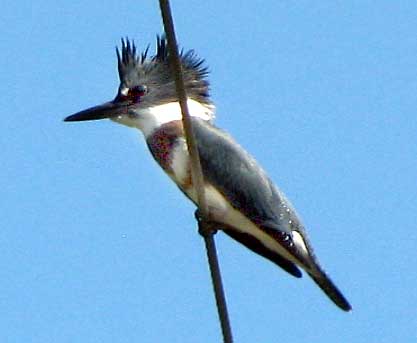Excerpts from Jim Conrad's
Naturalist Newsletter
from the August 30, 2009 Newsletter, issued from the Siskiyou Mountains west of Grants Pass, Oregon:
A BUSY KINGFISHER

As the dry season intensifies, the pond continues dropping and its few remaining fish find it ever harder to find refuge. Last week's Big Blue Heron has moved on but the Belted Kingfisher, MEGACERYLE ALCYON, visits more often than ever. In the morning as I work at the woodpile a loud KRRRRRRRRRRRR! shatters the quietness, there's a splash, I ready the camera and when he alights on a cable overhead, his eyes still searching the pond's depths, I get the picture shown here.
You know that this is a juvenile or female because mature males bear only one belt across the chest while this one has two. What surprised me was that this bird's upper or chest belt seems rusty-colored while I'm used to seeing gray chest belts. On the Internet I do find pictures of other birds with rusty chest belts so I'm guessing that this is a normal phase of the juvenile plumage. Anyone have an insight into that?
from the May 9, 2004 Newsletter, issued from near Natchez, Mississippi:
BELTED KINGFISHER IN THE WILLOWS
About an hour before dusk on Tuesday I was sitting on my plank inside the multi-trunked Black Willow at the Field Pond when I heard the neighborhood Belted Kingfisher flying across the field callings its harsh clatter-rattle. When the bird arrived at the pond I already had my binoculars in place, for I didn't want movement to reveal my presence. My stillness worked, for the bird landed on a willow branch not 15 feet away (4.5m) and never did discover me.
It was a female, easy to know because she had two belts across her white chest, not one. A broad, blue- gray band runs across the upper chest of both males and females, but only females have a second band, a chestnut-colored one below the blue-gray one.
One difference between that photo and what I saw is that my bird was backlighted by intense, late- afternoon sunlight slanting in low from the west. Every few seconds this bird would pump her tail, fan her crest and call, and when her crest went up sunlight caught in her silhouetted feathers like fire in the night. As she eyed the pond's surface, she held her massive, black beak open and I could see her slender tongue stiff and weaving up and down with anticipation. The sharp rims of her beak were so thin that they glowed translucently. Around her the willow's slender leaves fluttered in the late afternoon breeze, translating the crystalline sunlight into animated, mellow, yellow-green twinkle-shimmer. The bird was theater in which light, movement, sound and the struggle for existence interplayed. I'd seldom seen a creature so totally alert and alive. This bird looked and acted hungry not only for fish but also for anything and everything the next moment might provide.
Twice during her 20-minute visit she dove toward the pond's surface but broke away before hitting the water. On the third attempt she kept going, for half a second completely disappearing beneath the surface, her splash like a slow-motion explosion of a crystal chandelier. She emerged with her beak open and empty. Then she flew into the air, gave a kind of shake that fireworkslike sent sparkling water droplets cascading to the pond's surface, and flew away.